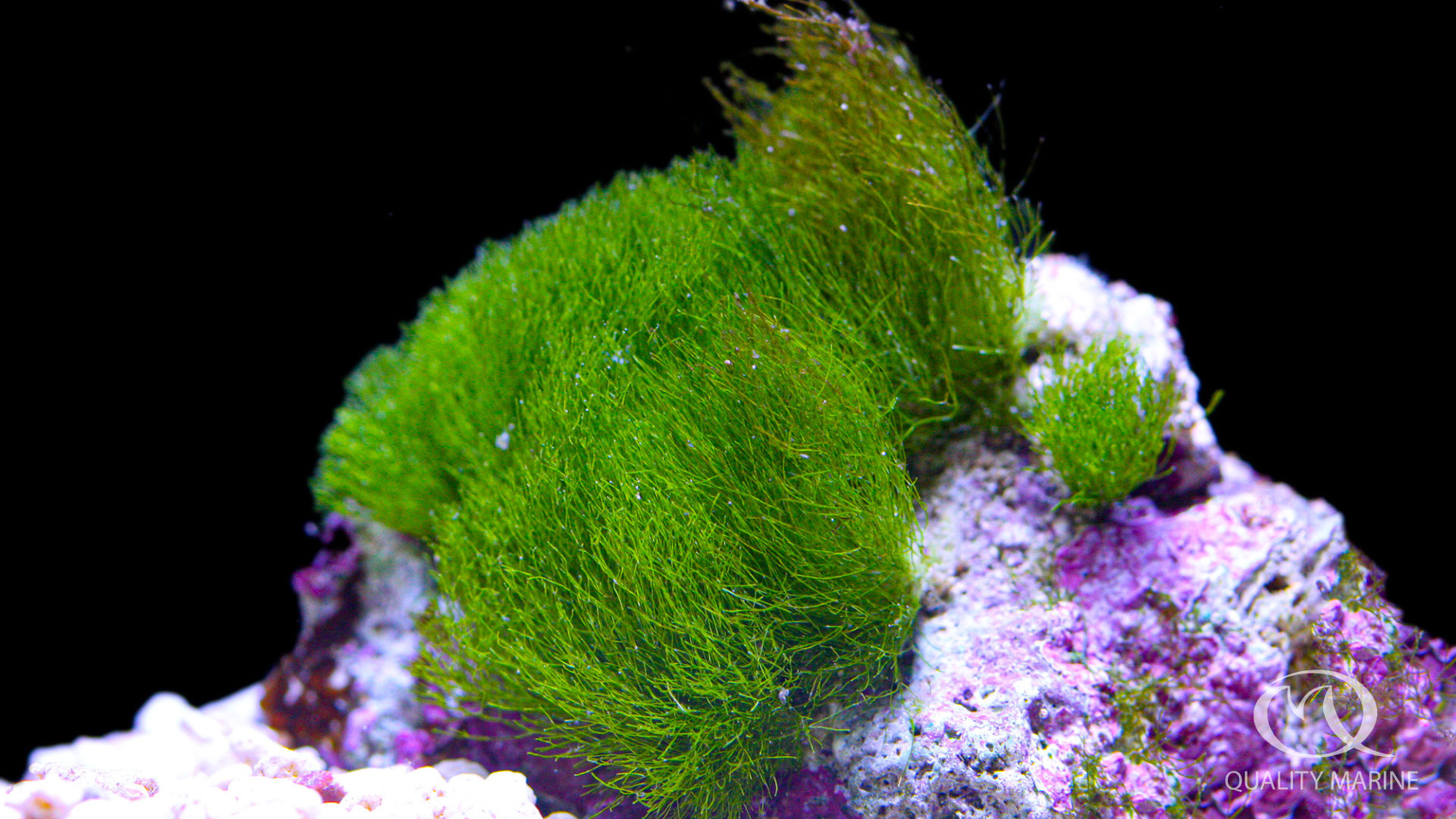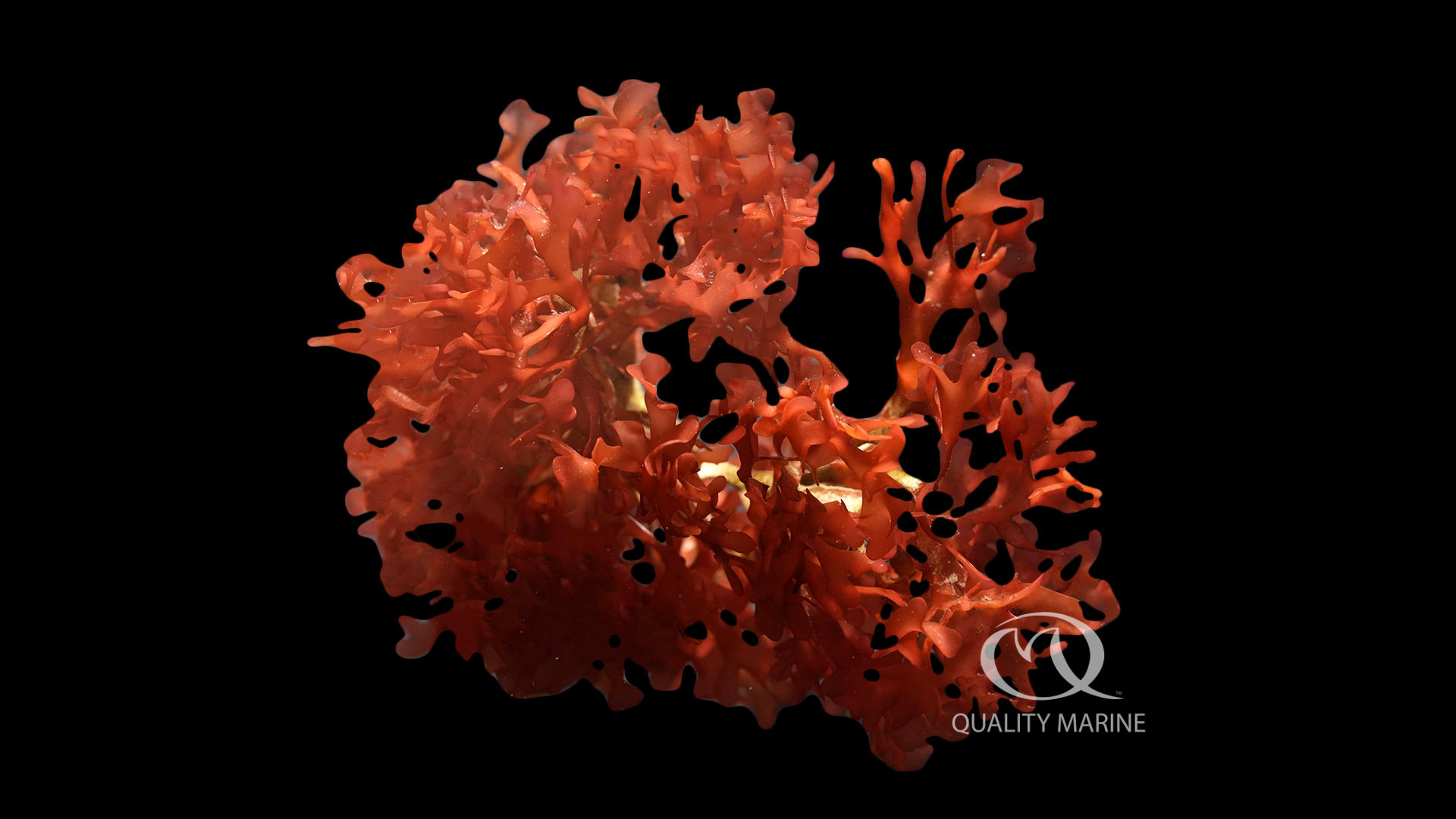A+ Algae

As we went over last week, algae in the marine environment were, until quite recently, nothing more than a plague and an eyesore, something to be fixed by attaining perfect, ultra-low nutrient levels in your aquarium. Those days, and methodologies have been replaced by refugiums, algae scrubbers, and in some cases, even going as far to grow algae in the display aquarium intentionally! Last week we talked at length on Caulerpa and the compelling arguments to avoid it at all costs. Today we will talk about some better choices for your display; all of them are commonly available genera you can source from any retail partner of Quality Marine.
Chaetomorpha or “Chaeto” as it is commonly referred to in the marine aquarium hobby, is probably the most commonly found alga on this list. It has been used in the marine aquarium for quite some time as a nutrient sponge, by growing quickly and then being harvested and removed from the system. In some studies, Chaeto grew over 50% in a single day! Chaeto does not attach to any surface but instead forms intertwined balls of algae which can be trimmed as they grow. While it can be kept in a display, mostly it is kept in a dedicated refugium which allows it to act as a safe haven for small invertebrates like “pods” and also it can be lit on a reverse photoperiod (opposite of the display lighting) to help balance out pH over the course of the day. It can be grown into easily managed ball shapes by using the flow through one’s sump with some forethought. One danger of Chaetomorpa is that it could become an invasive pest if not disposed of carefully; Chaeto can grow in a wide variety of salinities – ranging from almost freshwater to saltier than sea water. So, specimens should always be boiled or frozen or allowed to thoroughly dry out before being disposed of, as any of these will kill the algae. You could also give live cuttings to friends or back to your LFS if they have need.

Gracilaria is another fast-growing alga, but this one is a bit showier. There are more than 100 species but most available in the aquarium trade are red in color. These can be attached with super glue or a rubber band to rock work in your aquarium and as it grows, they will attach themselves to the structure. Gracilaria not only does a good job up taking nutrients, but it also is a very desirable food for herbivorous and omnivorous fish like tangs, angels and rabbitfishes. Gracilaria is found in warm waters around the world, and in every ocean aside the Arctic, as it dies below 50 degrees Fahrenheit. In addition to it being naturally widespread, this is a commonly farmed alga, both for human consumption and for making agar, or gelatin substitutes.
Chlorodesmis is a beautiful alga that is also known as Maiden’s Hair. It forms beautiful, lush carpets of rich green that will grow out over any hard structure it comes in contact with. While this alga is commercially available, it comes with a few notable differences compared to some of the earlier mentioned species. Most notably, the fact that the algae produce a mild toxin. Generally, this will be enough to keep most herbivorous fish from eating it, and while they might nip at it, this will only fragment it and potentially help it to spread. The toxin can also affect corals if the Maiden’s Hair crowds it too much. This species can also grow fast, consuming nutrients as it spreads over the rock, sand and even glass, so be intentional when using it in a display aquarium setting rather than a refugium. We’ve even seen someone who carved an Easter Island head out of cultured rock and used the Maiden’s Hair, for well, hair. (Maybe not the classiest display, but it was hilarious!)
Codium, also known as Green Finger Algae, is another widespread alga found all around the world except in arctic regions. It is farmed in Korea as a food product with many purported health benefits. In the aquarium it should be attached to a base with super glue, and it can be propagated by cutting and gluing more pieces in the same fashion.
Halimeda sp. is usually referred to simply as Halimeda, but also sometimes called the Money Plant, and Coin Algae, it is another very common algae throughout the tropics. Halimeda makes aragonite (calcium carbonate – the same stuff corals are made out of) and that can account for more than 60 percent of its mass. Halimeda can grow so fast and prolifically that in some places the sand in lagoons or even whole atolls have been made from dead Halimeda. Halimeda comes in a few forms. One form attaches itself to rocks, and another has root-like structures in sand or sends out runners on which other Halimeda can colonize off from. The best way to propagate Halimeda in the aquarium is fragmentation, or if growing in sand, simply wait for it to spread on its own, and isolate small portions as they grow. Halimeda was once thought to be unpalatable to fishes, but that has been disproven and some herbivores may eat your Halimeda. Halimeda will take some time to acclimate, and also uses available calcium faster than one might think once it is growing quickly. If you’d like it to spread, leave out the herbivore fish, use a longer light period and watch your CA/ALK levels carefully.
Ulva, or Sea Lettuce as it is sometimes called, grows fast and can have blades as big as twelve inches! It loves nutrient rich water and rapidly absorbs nutrients. It’s great in the aquarium or sump. It is widespread, and a favorite food item of both people and animals alike. As a food crop (which it also is) there is some risk of eating it in places where toxic substances / pollutants might be absorbed. To propagate, cut a small portion and glue it to a rock. Eventually it will form a holdfast (like plant roots, but for algae) and continue growing. It can be maintained like this in a sump where it will uptake nutrients, balance pH (if run on lights opposite of the display tank) and then can be used to feed tangs, rabbitfish, and anything else that might like fresh algae!
Penicillus sp. or Shaving Brush as this alga is commonly called, is another calcified marine alga like Halimeda. It grows to look like a shaving brush, reaching about four inches tall. The pencil-like stem should be buried into some fine substrate, and while it is common for them to lose their “bristles” during transport, they should grow back given proper conditions. Shaving Brush will send up more shoots from around the base of older established plants that will spread in that fashion, or that can be removed and transplanted as needed once they are mature. This is a slower growing alga, that looks amazing and flows well in current. Like the Halimeda it will require brighter lighting and demand more CA/ALK than most of the other alga on this list.
Botryocladia sp. is known as Red Grape Kelp. This alga is easily recognizable with its bright red color and the “grapes” it forms, which are actually small air bladders that help support the alga. This is another species that is a very desirable food for herbivorous fishes, and its deep-water collection means that it is well suited to the blue spectrums that are frequently used in “reef” aquarium lighting. That said, it is frequently collected in deeper waters, and so it is well suited to aquariums with less intense lighting, and if used in reef style aquaria, it should be very gradually acclimated to brighter lights, which might change the color to more of a yellow or orange color. You can propagate it by fragmentation; take small cuttings and affix them to new locations with glue or bands, etc. Also, when your fish spit out bits, if those bits land in good spots, they’ll become more RGK.
Algae is a new frontier in marine aquarium keeping, and one worth exploring. With some attention to detail of the specific needs of algae (maintaining nutrients for growth, adding a product to help replace things like Iron that are taken up faster in an algae themed aquarium than a reef tank, etc) one can find amazing color and movement, paired with beautiful shapes. They can be fast growing and useful as food. Ask your local fish store to bring in some cultured or sustainably sourced algae from Quality Marine and start planning your macro algae aquarium today!